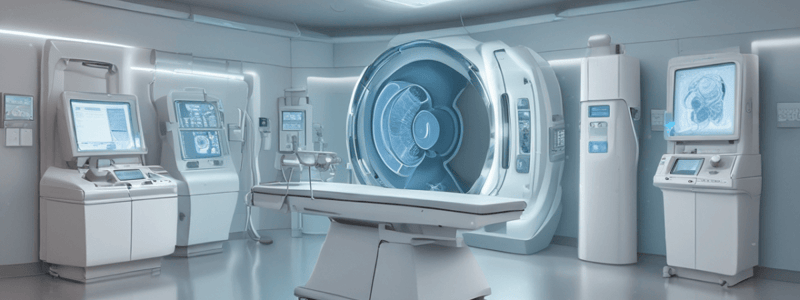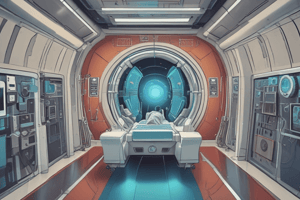Podcast
Questions and Answers
What is the primary difference between the 1st and 2nd generation scanners?
What is the primary difference between the 1st and 2nd generation scanners?
- Number of X-ray sources used
- Rotation mechanism used
- Type of beam used
- Number of detectors used (correct)
What is the name given to the geometry of the 1st generation scanner?
What is the name given to the geometry of the 1st generation scanner?
- Translate/Translate scanner
- Rotate/Rotate scanner
- Translate/Rotate scanner (correct)
- Rotate/Translate scanner
How many projections are obtained in a single scan in the 1st generation scanner?
How many projections are obtained in a single scan in the 1st generation scanner?
- 180 projections (correct)
- 360 projections
- 1 projection
- 1 projection per angle
What is the primary advantage of the 2nd generation scanner over the 1st generation scanner?
What is the primary advantage of the 2nd generation scanner over the 1st generation scanner?
What is the name of the beam used in the 2nd generation scanner?
What is the name of the beam used in the 2nd generation scanner?
How many detectors are typically used in a 3rd generation scanner?
How many detectors are typically used in a 3rd generation scanner?
What is the rotation range of the 3rd generation scanner?
What is the rotation range of the 3rd generation scanner?
What is a characteristic of 3rd generation scanners?
What is a characteristic of 3rd generation scanners?
What is an application of Electron Beam CT (EBCT) scanners?
What is an application of Electron Beam CT (EBCT) scanners?
What is a characteristic of 4th generation scanners?
What is a characteristic of 4th generation scanners?
What is the primary advantage of Dynamic Spatial Reconstruction (DSR) scanners?
What is the primary advantage of Dynamic Spatial Reconstruction (DSR) scanners?
What is a characteristic of 3rd generation scanners compared to 1st or 2nd generation systems?
What is a characteristic of 3rd generation scanners compared to 1st or 2nd generation systems?
What is a characteristic of 4th generation scanners?
What is a characteristic of 4th generation scanners?
What is the primary difference between Electron Beam CT (EBCT) scanners and conventional CT systems?
What is the primary difference between Electron Beam CT (EBCT) scanners and conventional CT systems?
What is the primary purpose of the special filter in the CT imaging system?
What is the primary purpose of the special filter in the CT imaging system?
What is the output of the analog-to-digital converter (ADC) in the CT imaging system?
What is the output of the analog-to-digital converter (ADC) in the CT imaging system?
What is the primary function of the X-ray tube in the CT imaging system?
What is the primary function of the X-ray tube in the CT imaging system?
What is the purpose of the detectors in the CT imaging system?
What is the purpose of the detectors in the CT imaging system?
What is the primary function of the computer in the CT imaging system?
What is the primary function of the computer in the CT imaging system?
What is the purpose of collimating the X-ray beam in the CT imaging system?
What is the purpose of collimating the X-ray beam in the CT imaging system?
What is the final outcome of the CT data acquisition process?
What is the final outcome of the CT data acquisition process?
What is the primary technology used in the fifth-generation scanner design?
What is the primary technology used in the fifth-generation scanner design?
How does the data acquisition speed of fifth-generation scanners compare to conventional CT systems?
How does the data acquisition speed of fifth-generation scanners compare to conventional CT systems?
What is a key difference in the data acquisition geometry of fifth-generation scanners compared to other generations?
What is a key difference in the data acquisition geometry of fifth-generation scanners compared to other generations?
What is the primary goal of the sixth-generation scanner design?
What is the primary goal of the sixth-generation scanner design?
What is a characteristic of seventh-generation scanners?
What is a characteristic of seventh-generation scanners?
What is an application of seventh-generation scanners due to their high spatial resolution?
What is an application of seventh-generation scanners due to their high spatial resolution?
What is a trade-off of the high spatial resolution in seventh-generation scanners?
What is a trade-off of the high spatial resolution in seventh-generation scanners?
What is the design of the sixth-generation scanner similar to?
What is the design of the sixth-generation scanner similar to?
What is the benefit of the dual-source design of the sixth-generation scanner?
What is the benefit of the dual-source design of the sixth-generation scanner?
Flashcards are hidden until you start studying
Study Notes
CT Imaging System
- Physics and Mathematical Concepts: The physical principles of CT involve physics and mathematical concepts to understand how the image is produced, including data acquisition, image reconstruction, and image display, manipulation, storage, and recording.
Data Acquisition
- Steps: The steps of CT data acquisition include X-ray tube and detectors in perfect alignment, scanning the patient to collect transmission measurements, shaping the beam with a special filter, collimating the beam to pass through the slice of interest, attenuating the beam by the patient, and measuring it with detectors.
- Conversion: The detectors convert X-ray photons into an electrical signal (analog data), which is then converted to digital data by an analog-to-digital converter (ADC) and sent to the computer for image reconstruction.
Scanner Generations
1st Generation Scanner
- Design: Single X-ray source and single X-ray detector cell to collect all data for a single slice.
- Beam: Pencil beam translated across the patient to obtain a set of parallel projection measurements at one angle.
- Source/Detector Rotation: The source and detector rotate slightly, and a subsequent set of measurements is obtained during translation past the patient.
- Translation and Rotation Process: This geometry is referred to as a translate/rotate scanner.
- Scan Time: 4.5 minutes for a single scan.
- Resolution: Very poor resolution.
2nd Generation Scanner
- Design: Multiple detectors (30 detectors) with a small fan beam.
- Translation: Source and array of detectors are translated as in a first-generation system.
- Multiple Projections: Multiple projections are obtained during each traversal past the patient.
- Scan Time: Reducing scan time (two to three minutes).
- Number of Detectors: Up to 53 detectors.
- Comparison: Faster than the 1st generation scanner.
3rd Generation Scanner
- Design: Larger array of detectors (300-700 detectors) with a wide fan beam.
- Rotation: Tube and detector array rotate around the patient.
- Projections: Different projections are obtained during rotation.
- Scan Time: Shorter scanning time (2 seconds).
- Spatial Resolution: High spatial resolution.
- Imaging Process: Significantly faster than 1st or 2nd generation systems.
4th Generation Scanners
- Design: Stationary detector ring and rotating X-ray tube (600 to 4,800 detectors) with a larger fan beam.
- Rotation: Only the X-ray generator and tube rotate at 360°.
- Scan Time: Shorter scanning time.
Fifth-Generation Scanner
- Design: High-speed scanner acquiring scan data in milliseconds.
- Applications: Primary application is cardiac imaging.
- Electron Beam CT Scanner (EBCT): A high-speed scanner capable of producing dynamic three-dimensional (3D) images.
- Dynamic Spatial Reconstruction (DSR): A highly specialized fifth-generation high-speed scanner capable of producing dynamic 3D images.
Sixth-Generation CT Scanners
- Design: Two X-ray tubes and two sets of detectors, resembling the third generation with an additional set of tube and detectors.
- Goal: Reduce scanning time, improving temporal resolution for imaging the heart.
Seventh-Generation CT Scanners
- Design: Flat-panel digital detectors, providing ultra-high spatial resolution, but lower contrast resolution, suitable for applications requiring sharpness, such as angiography.
Studying That Suits You
Use AI to generate personalized quizzes and flashcards to suit your learning preferences.




